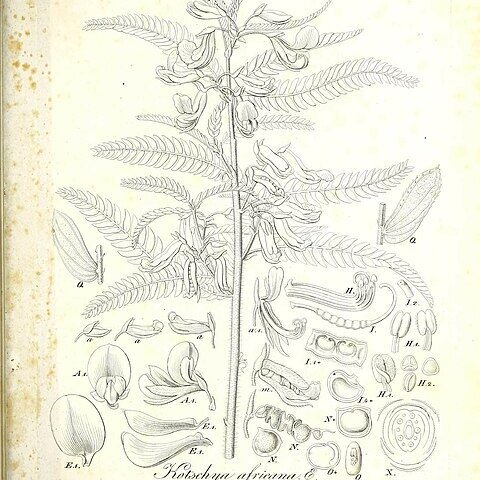Leaves 20–42-foliolate, leaflets 2–10(12.5) × 0.5–3.5(4) mm, oblong or oblong-lanceolate, slightly falcate and acute at the apex, obliquely or minutely emarginate at the base, glabrous or pubescent and with some tubercular-based hairs on the submarginal main nerve beneath, margins denticulate-ciliate; petiole and rhachis together 2–7.6 cm long; petiolules minute; stipules 3–7.5 × 1.2–3.5 mm, ovate-lanceolate, acute, margined or covered with tubercular-based hairs, scarious, veined, persistent.
Inflorescences axillary, dense, 1–few-flowered, not strobilate; peduncle 3–5 mm long or very short or obsolete; rhachis 2–6 cm long, mostly with bristly yellow hairs; pedicels 4–6 mm long; sterile bracts often several and conspicuous; bracts 3.5–8 × 1.3–3 mm, ovate, acute or acuminate, glabrescent or covered with bulbous-based hairs outside; bracteoles 3–7 × 1.2–2 mm, ovate-lanceolate, acute or acuminate, pubescent.
Calyx pubescent and bristly-hairy, 10–22 mm long, the upper lip emarginate or 2-fid for 0.5–3 mm, the lower lip deeply divided for just over half its length into 3 diverging lanceolate-acuminate lobes, the central one usually longest and narrowest.
Standard orange-yellow, often veined with reddish-purple, 9.5–18 × 4.5–10 mm, obovate or rounded, emarginate, glabrous; wings orange-yellow, hairy at apex; keel greenish-yellow, often veined with pale red, hairy at apex.
Seeds ochraceous or reddish-brown, 2–2.8 × 1.8–2.2 × 1–1.3 mm, depressed half-globose-reniform; hilum minute, eccentric.
Stems covered with glandular bristly tubercular-based hairs.
Fruit 4–9-jointed; articles 3–4 × 2–3.2 mm, pubescent.
Ovary 6–9-ovulate, pubescent.
Erect shrub 1–4.5(6) m tall.


